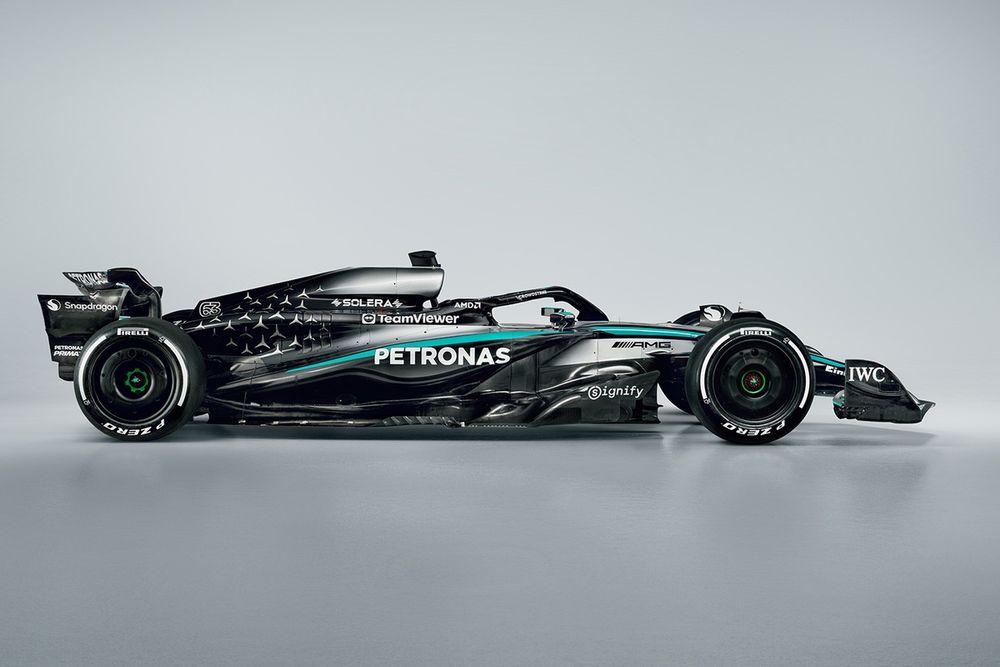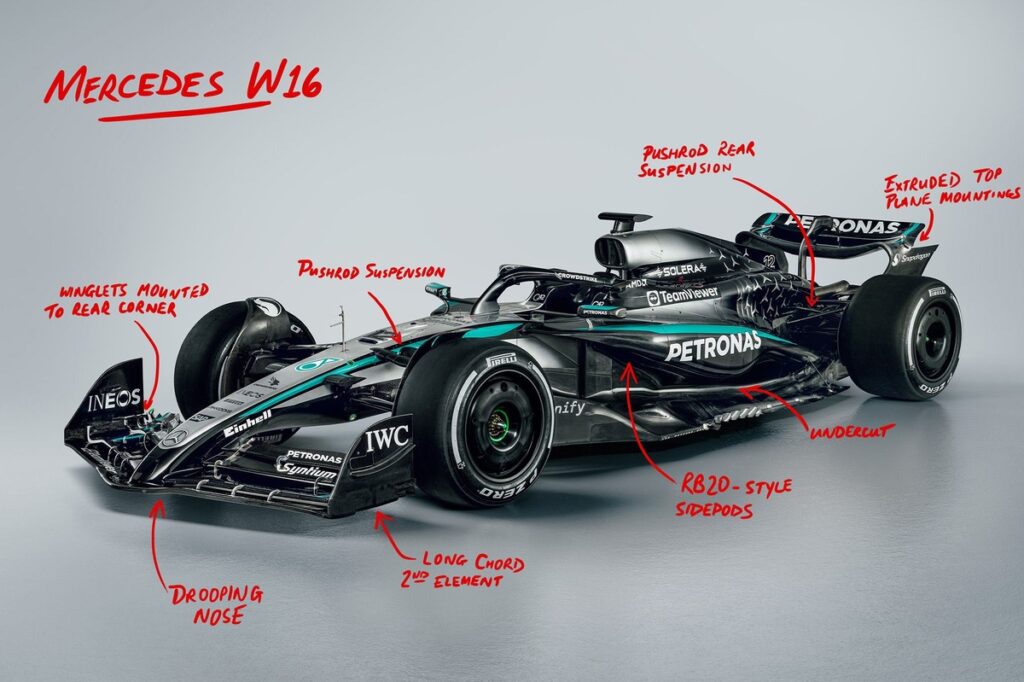The moving goalposts, when it comes to allegories and idioms about luck, sidestep from “third time’s the charm” to “bad luck comes in threes”. And, when it comes to Formula 1’s current technical regulations, Mercedes’ own expectations may make a similar step as its third car in this ruleset – the W15 – could not bring an end to the difficulties it has faced with building a consistent race winner.
Sure, it won the most races of any car it has produced since 2022, but the team was also a distant fourth behind McLaren, Ferrari, and Red Bull in the constructors’ championship. This rather lays the inconsistency of the W15 bare, as the car often struggled to walk a high-wire act between keeping its Pirelli tyres in their temperature window and overheating them to a point where the car rarely felt malleable for either George Russell or Lewis Hamilton. In cooler conditions with smoother track surfaces, this flaw was rarely an issue, but those stars had not aligned at the majority of 2024’s races…
Can the W16 fix those issues, and allow Mercedes to sign off from the current generation of car on a high? To do that, the team needs to have understood last year’s issues – and the issues experienced in the previous two seasons – and walk the line traced out by all of its previous misgivings by process of elimination.
Visually, there are myriad key differences compared to the W15 – which, in turn, was very different to the W14. It feels like Mercedes has covered every single possibility with its aero work over the past three years, and the car is now set off by a drooped, chiselled nose that extends further forward than its predecessor. The tip now sits halfway along the front wing mainplane, which is spoon shaped in the centre.
Many of the front wing’s mod-cons are evolutions of concepts that the team explored last year; the distribution of the four wing elements features a relatively short-chord mainplane and a long-chord second element, one that extrudes forwards at the junction with the endplate. The third and fourth elements are short in chord and feature the series of tiny details at their attachment point to the endplate seen last year; these link to an additional plate with tiny fins that duct airflow outwards through the gap in the endplate and around the front tyre to mitigate the effect of wake turbulence on the floor.
The team has stuck with a push-rod front suspension arrangement, deciding not to join its fellow front-running hopefuls with the switch to a pull-rod and benefit from the lower rocker position. Regardless, it has revised the position of its front suspension members, although it appears to be without the ‘adjustable’ upper wishbone where the team ran with a detachable panel that could place the rear leg at two different positions along the chassis flank.
Mercedes appears to have shifted towards Red Bull’s sidepod design on the RB20
Photo by: Autosport
Perhaps the biggest visible change to the formula comes with Mercedes’ adoption of Red Bull RB20-esque sidepods that feature a fully integrated inlet overwing and split inlets; one recessed into the undercut and the other along the chassis bulkhead. This has allowed the team to pursue a large undercut along the sidepods, one with a bulge underneath that should mitigate any potential generation of lift in this area and also allow space for the radiators to sit.
It appears as though the team is keeping its cards close to its chest with its floor, opting for one that ran in a similar specification (along the edges, at least) at the end of last season. There’s also a quasi-return of the high-sided engine cover, albeit not as extreme as the one run in 2023, as it has been moulded to shrink the bodywork around the rear suspension – which retains a push-rod layout.
Making the W16 a much more predictable customer, without the expense of losing any speed, will be the key between offering a genuine challenge for race wins and sinking further behind
Like Ferrari and Haas, Mercedes has swept the mountings of its upper wing plane further forward, which allows the mainplane to be partially cut away at the point at which it meets the endplate. This allows the aerodynamicists to play with vorticity here, giving the car the chance to generate airflow patterns that not only boost the effectiveness of the rear wing but allow it to link with the beam wing and the flow from the underbody.
Making the W16 a much more predictable customer, without the expense of losing any speed, will be the key between offering a genuine challenge for race wins and sinking further behind last year’s Big Three. The changes to the aerodynamics of the car have been all-encompassing, with further modifications under the skin to ensure that the car finally delivers on Mercedes’ aspirations to get back into more regular podium finishes.
With a rookie driver on board in Andrea Kimi Antonelli, the need for predictability is magnified. Considered to be a precocious-yet-raw talent, the Italian needs something he can rely on to ensure he can get a proper grounding in F1; a year with last year’s car would likely hamper his learning experience behind the wheel. It’ll be up to Russell to lead the development from the cockpit, and he’ll be a demanding influence on the team; if he doesn’t think the new car is up to scratch, he’ll say it. Without Hamilton’s aura, Mercedes could be forgiven for missing something; Russell must fill that void.
Subscribe to Autosport Plus for more Formula 1 technical and in-depth analysis ahead of the 2025 season.

Can the W16 push Mercedes back into the fight for titles?
Photo by: Mercedes AMG
In this article
Jake Boxall-Legge
Formula 1
Mercedes
Be the first to know and subscribe for real-time news email updates on these topics
Subscribe to news alerts
Read the full article here

